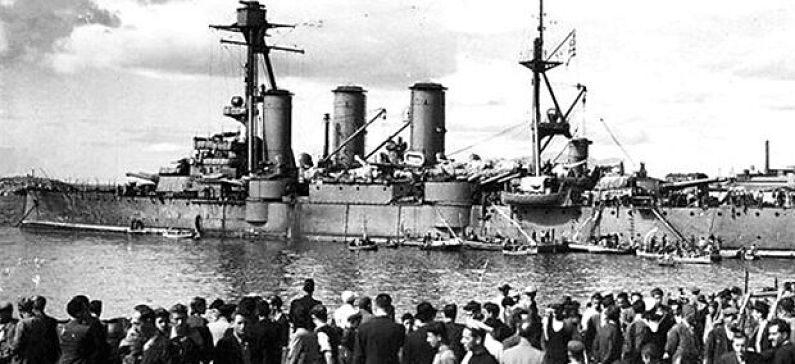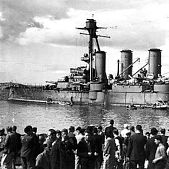
On this day: Reception of a legendary ship of the Greek Navy
It was on this day, September 1, 1911, when the port of Piraeus was filled with hundreds of citizens, who gathered with great enthusiasm to welcome the arrival of a warship, whose name, in the course of time, was written in gold letters in the history of Greece.
On 27 February 1910, the battleship “Averoff” was launched for the first time and after a short voyage to England on the occasion of the coronation of King George V, she was delivered to Greece on 15 May 1911 and on 1 September 1911, she sailed into the bay of Faliro.
The history-changing event was written in Livorno, Italy, where the ship was built for the needs of the Italian Navy, but the order was subsequently cancelled. This news prompted the government of Kyriakoulis Mavromichalis to express an interest in purchasing her, around the end of 1909, while anticipating the Turks, who had expressed a similar interest. After the unfortunate outcome of the Greek-Turkish war of 1897, our country had embarked on an extensive modernization of its armed forces with emphasis on the navy, as the fleet up to that time had been obsolete and in order for dominance in the Aegean to occur, the inclusion of new, modern ships was required.
The then Minister of the Navy, Ioannis Damianos, known for his negotiating skills, managed to reduce the cost of the armoured cruiser to 24,000,000 drachmas. One third of the amount was paid from the bequest of the Epirus businessman and national benefactor Georgios Averoff (1815-1899) and for this reason the ship was named after him.
At that time, it was considered a state-of-the-art, steam-powered ship, with a maximum cruising speed of 24 knots and a crew of 20 officers and 680 sailors.
With this as the flagship of our naval fleet, we managed to change the balance in the Aegean. From the beginning of the First Balkan War, the “Averoff” imposed its presence and gave Greece a completely different operational capability. Admiral Kountouriotis, commander of the “Averoff”, wrote his own history by leading the victorious naval battles of Elli in December 1912 and Lemnos in January 1913 against the Turkish fleet, showing once again that the naval prowess of the Greeks is unsurpassed.
With Greece being one of the victorious powers of the First World War, in October 1918 the “Averoff” anchored in Istanbul and raised the Greek flag opposite the Sultan’s palace.
His contribution in the summer of 1922 was notable, when after the collapse of the Asia Minor front, he helped to transport the troops and the uprooted Greeks to the coast of Ionia.
During the Second World War, now aged, she remained the flagship of the Greek fleet. In April 1941, after the German invasion, there was a thought of sinking her so that she would not be surrendered to the enemy, but she was subsequently abandoned. “Averoff” continued to operate in Alexandria and for the rest of the war she participated in convoys in the Indian Ocean.
The epilogue of the battleship “Averoff” was written with her last two – peaceful missions. The transfer of the Liberation Government of George Papandreou to Piraeus on 17 October 1944 and his trip to Rhodes on 15 May 1945, where he brought the message of the annexation of the Dodecanese to Greece.
The ship was refitted in 1952 and to this day it is still in Faliro, where it operates as a War Museum.
The battleship “Georgios Averoff” is a legendary ship of the Greek Navy. It is difficult to find a similar ship in world history that has been associated for so many years with the history of a nation.








